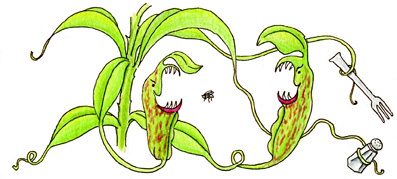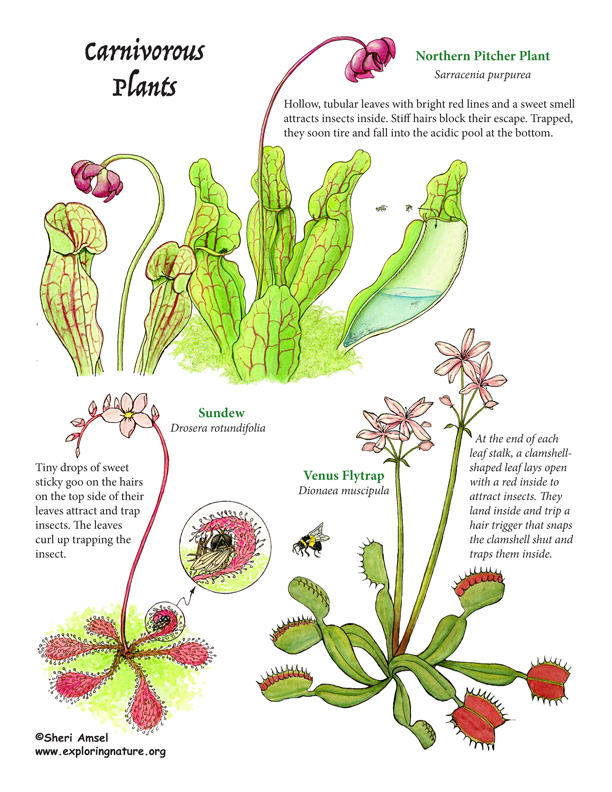

Even though plants can make their own food, using sunlight and the process of photosynthesis, they also need soil rich with minerals to help them grow. Wetlands, like swamps, bogs and peat marshes, have soil that is so wet that their minerals have been washed away making it more dfficult for plants to grow in them. Some plants have developed special adaptations to get the minerals they need. They eat insects – they are insectivorous – and sometimes even small amphibians and mammals!
How does a plant, that has no muscles to move catch its prey? Carnivorous plants catch their prey in several different ways. Read about three different carnivorous plants and the three ways they trap their prey.
Roundleaf Sundew
Roundleaf sundews (Drosera rotundifolia L.) are small, delicate plants that have tiny drops of sweet, sticky nectar-like goo on the hairs on the top sides of their leaves. Insects see the “nectar” glistening in the sun and fly in to take a taste, but when they land on the leaf, instead of nectar, they find themselves stuck in glue. As the insect struggles, it triggers the sundew leaf to begin to curl up, trapping the fly inside. Then the sundew digests the insects and absorbs its nutrients.
Northern Pitcher Plant
Another carnivorous plants is the northern pitcher plant – Sarracenia purpurea. Found in sphagnum bogs, this carnivorous plant has a nodding, purplish-red flower on a tall stalk. The flower can grow up to two feet tall and blooms from June through July. The specially adapted leaves are long, hollow “pitchers” that are green with purple veins that act like run ways down into the plant which gives off an attractive, sweet smell. Inside, there are stiff hairs that point downward that let insects walk down, but make walking back out very difficult. The leaves fill with water which drowns the trapped insects. The plant secretes an acidic enzyme that mixes with the water and dissolves the insect. It’s nutrients are absorbed by the plant.
Venus Flytrap
Venus Flytraps (Dionaea muscipula) are found in bogs and other nitrogen-poor environments in North and South Carolina, though have been introduced in other places. It grows a long flower stem with 5-petaled, white flowers at the end. They have up to 7 long leaves, each with an adapted “trap” at the end. The “trap” is a hinged, clamshell-like structure with a smooth, red inside and a hair-like fringe along the edge. The red color inside the clam-shell attracts insects to land and look for food. There are three stiff trigger hairs inside that, when touched by an insect, will cause the trap to snap shut. It is then sealed by the fringed edge. The plant secretes an acidic enzyme that dissolves the insect. It’s nutrients are absorbed by the plant.
When you research information you must cite the reference. Citing for websites is different from citing from books, magazines and periodicals. The style of citing shown here is from the MLA Style Citations (Modern Language Association).
When citing a WEBSITE the general format is as follows.
Author Last Name, First Name(s). "Title: Subtitle of Part of Web Page, if appropriate." Title: Subtitle: Section of Page if appropriate. Sponsoring/Publishing Agency, If Given. Additional significant descriptive information. Date of Electronic Publication or other Date, such as Last Updated. Day Month Year of access < URL >.
Amsel, Sheri. "Carnivorous Plants" Exploring Nature Educational Resource ©2005-2024. December 13, 2024
< http://www.exploringnature.org/db/view/Carnivorous-Plants >



